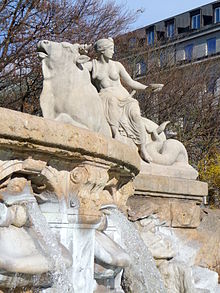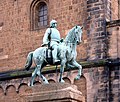Adolf von Hildebrand




Adolf Hildebrand , from 1903 Knight von Hildebrand , (born October 6, 1847 in Marburg , † January 18, 1921 in Munich ) was one of the leading German sculptors of his time and medalist .
Life
Adolf Hildebrand grew up in Bern , where his father Bruno Hildebrand taught economics . His mother was Clementine Guttentag, who came from a Jewish family. He studied at the royal. Nuremberg art school and from 1866 to 1867 in the studio of Kaspar von Zumbusch in Munich. Soon afterwards he traveled to Rome , where he met Hans von Marées and Konrad Fiedler .
Despite its success and its impact beyond the German-speaking area, Hildebrand was temporarily attacked at home because of his orientation towards the Italian Renaissance and his extended stays in Italy (Hildebrand bought a former monastery in 1874, today's Villa di San Francesco di Paola in Florence ). because his art was seen as "too little German". For a long time von Hildebrand had his main residence in Florence. It was not until 1898 that he moved into a villa he designed himself in the Bogenhausen district of Munich , which soon became the meeting place for Munich society - today known as the Hildebrandhaus . Von Hildebrand was married to Irene, née Koppel-Schäufelen, and they had six children. His most important student is his son-in-law Theodor Georgii , who rebuilt Hildebrand's Wittelsbach fountain in Munich , which was destroyed in World War II . Another son-in-law, Carl Sattler , was a German architect and university professor.
Hildebrand died in Munich at the age of 74. He is buried in the Oberföhringen cemetery.
Honors
- From 1891 Hildebrand was a member of the Prussian order Pour le Mérite for science and the arts .
- In 1898 he was made an honorary member of the Dresden Art Academy .
- In 1903 he was given the Bavarian nobility, and in 1913 the hereditary nobility.
- His bust has been in the Munich Hall of Fame since 1987
student
plant

Hildebrand's sculptures and sculptures have classical, “Mediterranean” features. They are characterized by a clear, reduced and calm design. Hildebrand advocated a clear and perfect design of the work of art without superfluous details. His preferred subject was the human figure , which generally appeared to him to be the most distinguished subject of art. He often tried to integrate a sculptural work into a larger whole, which ultimately led Hildebrand to more and more urban planning tasks. Hildebrand soon became a leader in Germany in the field of fountain and monument art.
Hildebrand's theoretical work The Problem of Form in Fine Art (1893) was influenced by the considerations of his friend and sponsor Konrad Fiedler. It has particularly influenced art history - and here in particular the art historian Heinrich Wölfflin . In his work, Hildebrand starts from the principle that "the work of art [...] must be eye-fair" (Wölfflin). For every work there is an ideal point of observation . For the sculpture, which is usually viewed from a distance , this means that it has to take into account the two-dimensionality of human perception : Reduction and renunciation of details thus become Hildebrand's working maxims - similar to Auguste Rodin , who is seven years older than him . The relief , which according to Hildebrand ideally corresponds to human intuition, becomes the normative measure of plastic in general.
Individual works
Fountain
- Bismarck fountain Jena , 1894
- Wittelsbacher Brunnen (Munich) , 1895
- Father Rhine Fountain , Strasbourg , 1903, in Munich since 1932
- Hubertusbrunnen (Munich) , 1907
- Siegfriedbrunnen (Worms) , 1913
Monuments
- Brahms monument (Meiningen) , 1899
- Schiller Monument, Nuremberg City Park , 1909
- Bismarck Monument (Bremen) , 1910
- Ernst Bergmann Monument , Tartu , Estonia, 1913
- Equestrian statue of Prince Regent Luitpold, Munich Luitpoldstrasse, 1913
Tombs
- Grave monument to Duke Carl Theodor in Bavaria , Tegernsee Monastery , 1913
- Hans von Bülow's tomb , Ohlsdorf cemetery , Hamburg , 1896
- Heinrich von Herzogenberg tomb , Nordfriedhof (Wiesbaden) , 1901
- Hermann Levi Mausoleum , Partenkirchen , 1900/01
Fonts
- The problem of form in the fine arts. Strasbourg 1893.
- Henning Bock (Ed.): Collected writings on art. Cologne / Opladen 1969.
literature
- Elisabeth Decker: On the artistic relationship between Hans von Marées, Konrad Fiedler and Adolf Hildebrand. Dissertation, University of Basel, 1967.
- Isolde Kurz : Adolf Hildebrand. For his 60th birthday. In: Deutsche Rundschau . Vol. 133, October 1907, pp. 105-129.
- Werner Mittlmeier: Hildebrand, Adolf Ritter von. In: New German Biography (NDB). Volume 9, Duncker & Humblot, Berlin 1972, ISBN 3-428-00190-7 , p. 119 f. ( Digitized version ).
- Lorenz Maier : Hildebrand, Adolf von. In: Karl Bosl (ed.): Bosls Bavarian biography. Pustet, Regensburg 1983, ISBN 3-7917-0792-2 , p. 347 f. ( Digitized version ).
- Heinrich Wölfflin : In memory of Adolf von Hildebrand. In: Small Fonts. 1886–1933, Basel 1946.
- Sigrid Esche-Braunfels: Adolf von Hildebrand. German publishing house for art studies, Berlin 1993.
gallery
The equestrian statue of the Bremen Bismarck monument , 1910
Web links
- Werner Mittlmeier, Hildebrand, Adolf Ritter von , in: Neue Deutsche Biographie , Volume 9 (1972), p. 119 f. ( online )
- www.adolf-von-hildebrand.de (extensive page on life and work)
- Literature by and about Adolf von Hildebrand in the catalog of the German National Library
- The estate is in the Bavarian State Library
- Adolf Hildebrand In: E-Periodica
Individual evidence
- ^ Adolf Ritter von Hildebrand. Artist. German Society for Medal Art, accessed on November 17, 2015 .
- ↑ history of the Hildebrandhaus , accessed on February 9, 2017
- ↑ The Order Pour le Mérite for Science and the Arts, The Members of the Order, Volume II (1882–1952), page 80, Gebr. Mann-Verlag, Berlin, 1978
- ^ Archive of the Dresden University of Fine Arts
- ↑ http://sites.google.com/site/adolfvonhildebrand/home/das-problem-der-form
- ^ Sigrid Esche-Braunfels: Adolf von Hildebrand (1847–1921) . Deutscher Verlag für Kunstwissenschaft, Berlin 1993, ISBN 3-87157-144-X , p. 397 ff .
- ↑ Peter Pinnau: Crypt, mausoleum, burial chapel: studies on sepulchral architecture of the 19th and 20th centuries with a special focus on Adolf von Hildebrand . Mäander-Verlag, Munich 1992, ISBN 3-88219-366-2 .
| personal data | |
|---|---|
| SURNAME | Hildebrand, Adolf von |
| ALTERNATIVE NAMES | Hildebrand, Adolf Ritter von (full name); Hildebrand, Adolf |
| BRIEF DESCRIPTION | German sculptor |
| DATE OF BIRTH | October 6, 1847 |
| PLACE OF BIRTH | Marburg |
| DATE OF DEATH | January 18, 1921 |
| Place of death | Munich |








